
The Genus Fuchsia
Section Quelusia (Vand.) DC., 1828
(nine species)
All nine species in this section are found in cool forest habitats with eight in southeastern Brazil, from Minas Gerais to Rio Grande do Sul, and one, F. magellanica, occurring from the Andes and coastal slopes of southern Chile and Argentina between thirty-three and fifty-five degrees south latitude (Berry 1989). These shrubs or lianas have opposite or whorled leaves. The pendulous, or rarely divergent, flowers are axillary, solitary or rarely in pairs with a floral tube 3 to 15 mm long, and have smooth or weakly lobed, band-type nectaries. The sepals are longer than the floral tube, partly connate and colored red. The petals are convolute and blue-violet. The stamens occur in two unequal series and are strongly exserted. They have yellow pollen. The seed count is between 60 and 120.
This section is named after Queluz Palace, the summer residence of the former Kings of Portugal, located in Queluz near Lisbon. Domenico Vandelli, first applied Quelusia to a Brazilian fuchsia, listed without a specific epithet but probably Fuchsia coccinea, provided to him by Joaquim Veloso de Miranda. José Mariano de Conceição Veloso also used Quelusia regia in his Florae Fluminensis (1825–27). The name was synonymized with Fuchsia but later revived by the Swiss botanist Augustin Pyramus de Candolle (1778 -1841) for one of the two sections into which he divided the genus in 1828.
Name: Fuchsia Sect. Fuchsia autonomy
Typus: F. magellanica Lam.
Synonyms
Basionym
Quelusia Vand., Fl. Lusit. Bras. Spec. 23. 1788.
Heterotypic
Kierschlegeria Spach, Hist. Nat. Veg. 4: 403. 1835; Fuchsia sect. Kierschlegeria (Spach) Munz, Proc. Calif. Acad. Sci., ser. 4, 25: 69. 1943.
Type species: K. lycioides (Andrews) Spach
Nahusia Schneev., Icon. Pl. Rar. (Schneevoogt) 21. 1792.
Type species: N. coccinea Schneev.
Thilcum Molina, Sag. Stor. Nat. Chili, ed. 2. 146. 1810.
Type species: T. tinctorum Molina
Section Quelusia (Vand.) DC., 1828
(nine species)
All nine species in this section are found in cool forest habitats with eight in southeastern Brazil, from Minas Gerais to Rio Grande do Sul, and one, F. magellanica, occurring from the Andes and coastal slopes of southern Chile and Argentina between thirty-three and fifty-five degrees south latitude (Berry 1989). These shrubs or lianas have opposite or whorled leaves. The pendulous, or rarely divergent, flowers are axillary, solitary or rarely in pairs with a floral tube 3 to 15 mm long, and have smooth or weakly lobed, band-type nectaries. The sepals are longer than the floral tube, partly connate and colored red. The petals are convolute and blue-violet. The stamens occur in two unequal series and are strongly exserted. They have yellow pollen. The seed count is between 60 and 120.
This section is named after Queluz Palace, the summer residence of the former Kings of Portugal, located in Queluz near Lisbon. Domenico Vandelli, first applied Quelusia to a Brazilian fuchsia, listed without a specific epithet but probably Fuchsia coccinea, provided to him by Joaquim Veloso de Miranda. José Mariano de Conceição Veloso also used Quelusia regia in his Florae Fluminensis (1825–27). The name was synonymized with Fuchsia but later revived by the Swiss botanist Augustin Pyramus de Candolle (1778 -1841) for one of the two sections into which he divided the genus in 1828.
Name: Fuchsia Sect. Fuchsia autonomy
Typus: F. magellanica Lam.
Synonyms
Basionym
Quelusia Vand., Fl. Lusit. Bras. Spec. 23. 1788.
Heterotypic
Kierschlegeria Spach, Hist. Nat. Veg. 4: 403. 1835; Fuchsia sect. Kierschlegeria (Spach) Munz, Proc. Calif. Acad. Sci., ser. 4, 25: 69. 1943.
Type species: K. lycioides (Andrews) Spach
Nahusia Schneev., Icon. Pl. Rar. (Schneevoogt) 21. 1792.
Type species: N. coccinea Schneev.
Thilcum Molina, Sag. Stor. Nat. Chili, ed. 2. 146. 1810.
Type species: T. tinctorum Molina
F. alpestris Gardner
Brazil. Found in thickets and low forest near granitic outcrops of several morros in north-central Rio de Janeiro state, Brazil and also near Nova Friburgo, Santa Maria Madalena, as well as in the Serra dos Órgãos between Teresópolis and Petrópolis at elevations from 1,400 to 1,600 meters.
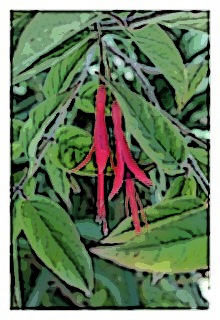
Flowering is mainly from November to March.
Habit—Scandent shrubs one to five meters tall, branches generally long and hanging, up to five meters long. Branchlets reddish tan, densely pilose with erect, whitish hairs about 1 mm long.
Leaves—Opposite, occasionally ternate, membranous, oblong, broadly ovate or narrowly elliptic-ovate, (55 to) 60 to 140 mm long, 20 to 70 mm wide, apex acute to acuminate, base rounded to subcordate or subauriculate, moderately pilose above, densely pilose below, sometimes purple-flushed when young, often yellowing before dehiscing; margin entire to subdenticulate, secondary veins 5 to 9 (to 10) per side. Petioles densely pubescent, 3-6 mm long, stout and 2 to 4 mm thick on older leaves, canaliculate above. Stipules narrowly triangular, 1 to 2 mm long, 0.8 to 1.5 mm wide, adjacent ones sometimes fused, generally covered by hairs.
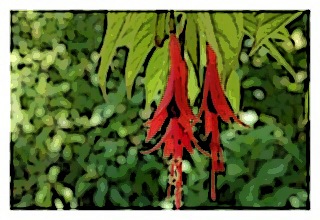 Flowers—Few and solitary in upper leaf axils, pedicels pendulous, 25 to 40 mm long, ovary subquadrangular, pilose, 6 to 8 mm long, 2 to 3.5 mm wide, floral tube cylindrical-fusiform, (5 to) 6 to 8 (to 10) mm long, 3 to 4 mm wide, pubescent outside, pilose inside, nectary 4 to 6 mm high, 1 mm thick, irregularly ridged, sepals 18 to 26 (to 28) mm long, connate for 4 to 6 mm at the base, pilose outside, free lobes 3.5 to 4.5 mm wide at base, spreading at anthesis. Tube and sepals red to dull pink, petals violet, broadly obovate, 10 to 14 mm long, 8 to 9 mm wide, filaments red, 26 to 35 mm and 24 to 32 mm long, anthers red, oblong, 2.5 to 3.5 mm long, 1.2 to 1.6 mm wide, style red, pilose in basal third, stigma red, clavate, 2.5 to 3.5 mm long, 1.1 to 1.6 mm wide.
Flowers—Few and solitary in upper leaf axils, pedicels pendulous, 25 to 40 mm long, ovary subquadrangular, pilose, 6 to 8 mm long, 2 to 3.5 mm wide, floral tube cylindrical-fusiform, (5 to) 6 to 8 (to 10) mm long, 3 to 4 mm wide, pubescent outside, pilose inside, nectary 4 to 6 mm high, 1 mm thick, irregularly ridged, sepals 18 to 26 (to 28) mm long, connate for 4 to 6 mm at the base, pilose outside, free lobes 3.5 to 4.5 mm wide at base, spreading at anthesis. Tube and sepals red to dull pink, petals violet, broadly obovate, 10 to 14 mm long, 8 to 9 mm wide, filaments red, 26 to 35 mm and 24 to 32 mm long, anthers red, oblong, 2.5 to 3.5 mm long, 1.2 to 1.6 mm wide, style red, pilose in basal third, stigma red, clavate, 2.5 to 3.5 mm long, 1.1 to 1.6 mm wide.
Fruit—The berry is oblong-ellipsoid, 14 to 16 mm long, 8 to 10 mm wide, and purple when ripe.
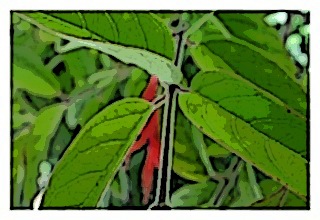 Seeds—Oblong, 1.8 to 2.2 mm long and 1 to 1.5 mm wide.
Seeds—Oblong, 1.8 to 2.2 mm long and 1 to 1.5 mm wide.
Chromosomes—Gametic chromosome number n = 22, 44.
Authors—Gardner 1842. (Gardner) Munz 1943. Berry 1989.
Original publication—Bot. Mag. 69: t. 3999 1843.
Synonyms—F. mollis, Krause 1906; F. regia var. alpestris.
Herbaria—Kew 1; Kew 2.
Brazil. Found in thickets and low forest near granitic outcrops of several morros in north-central Rio de Janeiro state, Brazil and also near Nova Friburgo, Santa Maria Madalena, as well as in the Serra dos Órgãos between Teresópolis and Petrópolis at elevations from 1,400 to 1,600 meters.

Flowering is mainly from November to March.
Habit—Scandent shrubs one to five meters tall, branches generally long and hanging, up to five meters long. Branchlets reddish tan, densely pilose with erect, whitish hairs about 1 mm long.
Leaves—Opposite, occasionally ternate, membranous, oblong, broadly ovate or narrowly elliptic-ovate, (55 to) 60 to 140 mm long, 20 to 70 mm wide, apex acute to acuminate, base rounded to subcordate or subauriculate, moderately pilose above, densely pilose below, sometimes purple-flushed when young, often yellowing before dehiscing; margin entire to subdenticulate, secondary veins 5 to 9 (to 10) per side. Petioles densely pubescent, 3-6 mm long, stout and 2 to 4 mm thick on older leaves, canaliculate above. Stipules narrowly triangular, 1 to 2 mm long, 0.8 to 1.5 mm wide, adjacent ones sometimes fused, generally covered by hairs.

Fruit—The berry is oblong-ellipsoid, 14 to 16 mm long, 8 to 10 mm wide, and purple when ripe.

Chromosomes—Gametic chromosome number n = 22, 44.
Authors—Gardner 1842. (Gardner) Munz 1943. Berry 1989.
Original publication—Bot. Mag. 69: t. 3999 1843.
Synonyms—F. mollis, Krause 1906; F. regia var. alpestris.
Herbaria—Kew 1; Kew 2.
F. bracelinae Munz
Brazil. Endemic to the highest peaks of the Serra do Caparaó (Pico da Bandeira, Pico do Cristal, Picodo Cruzeiro, and Pico do Calçado) along the border of the states of Minas Gerais and Espírito Santo. It grows in the open campos above the tree line at elevati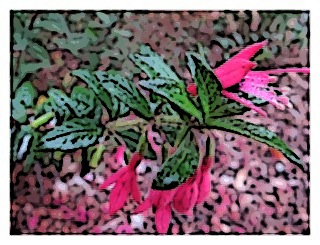 ons from 2,280 to 2,850 meters, but is most common between 2,700 and 2,800 meters.
ons from 2,280 to 2,850 meters, but is most common between 2,700 and 2,800 meters.
Flowering is mainly during the summer months from primarily from November to March.
Habit—A few to many-branched subshrub, 10 to 60 cm tall, or occasionally a scandent shrub to two meters high in dense shrubbery. Branchlets terete, generally reddish purple, densely pilose with erect, whitish hairs about 1 mm long. Older branches are with freely exfoliating bark.
Leaves—Three to five-verticillate, membranous, narrowly elliptic-lanceolate, 20 to 50 mm long, 7 to 1 7 mm wide, apex narrowly acute, base rounded, green and slightly strigose above with conspicuously impressed veins, paler and usually purple-flushed below and densely pilose on the sulcate veins and margins, margin subentire to gland-denticulate, secondary veins four to seven per side. Petioles green to reddish, pilose, 1 to 3 mm long, stipules lanceolate, with a thick base, 1.5 to 2 mm long, adjacent ones often fused basally, subpersistent.
Flowers—Solitary in upper leaf axils, pedicels slender, pilose, pendulous, 12 to 20 mm long, ovary oblong, strigillose to pilose, 4.5 to 8 mm long, 2 to 3 mm wide, floral tube cylindrical-fusiform, 3.5 to 7 mm long, 2 to 4 mm wide, lightly strigillose to pilose outside, glabrous inside, nectary 2.5 to 3.5 mm high, about 1 mm thick and slightly ridged, sepals 19 to 26 mm long, narrowly lanceolate to elliptic-ovate, connate at the base for 3 to 5 (to 6) mm, free lobes 5 to 8 mm wide at the base, apex acuminate, spreading at anthesis. Tube and sepals light red to pink, petals deep violet, broadly obovate, 10 to 15 mm long, 6.5 to 9 mm wide, apex rounded, filaments reddish purple, 24 to 30 mm and 17- to mm long, anthers elliptic, 2.5 to 3 mm long, 1.2 to 1.6 mm wide, style light red, glabrous, stigma reddish, clavate to subglobose, 1.5 to 3 mm long, 1 to 1.5 mm wide, exserted 5 to 14 mm beyond the anthers.
Fruit—The young berries are oblong. Mature ones have not been described.
Seeds—Unknown.

Chromosomes—Gametic chromosome number n = 22.
Notes: Flowers in the summer, principally from November until March.Authors—Munz 1943. Berry 1989.
Original publication—Proc. Calif. Acad. Sci. IV, 25: 7 1943.
Herbaria—California Academy; Missouri (type specimen); New York 1, New York 2; Smithsonian.
See also ➤ Bracie's Fuchsia on the Urban Fuchsia + Blog.
Brazil. Endemic to the highest peaks of the Serra do Caparaó (Pico da Bandeira, Pico do Cristal, Picodo Cruzeiro, and Pico do Calçado) along the border of the states of Minas Gerais and Espírito Santo. It grows in the open campos above the tree line at elevati

Flowering is mainly during the summer months from primarily from November to March.
Habit—A few to many-branched subshrub, 10 to 60 cm tall, or occasionally a scandent shrub to two meters high in dense shrubbery. Branchlets terete, generally reddish purple, densely pilose with erect, whitish hairs about 1 mm long. Older branches are with freely exfoliating bark.
Leaves—Three to five-verticillate, membranous, narrowly elliptic-lanceolate, 20 to 50 mm long, 7 to 1 7 mm wide, apex narrowly acute, base rounded, green and slightly strigose above with conspicuously impressed veins, paler and usually purple-flushed below and densely pilose on the sulcate veins and margins, margin subentire to gland-denticulate, secondary veins four to seven per side. Petioles green to reddish, pilose, 1 to 3 mm long, stipules lanceolate, with a thick base, 1.5 to 2 mm long, adjacent ones often fused basally, subpersistent.
Flowers—Solitary in upper leaf axils, pedicels slender, pilose, pendulous, 12 to 20 mm long, ovary oblong, strigillose to pilose, 4.5 to 8 mm long, 2 to 3 mm wide, floral tube cylindrical-fusiform, 3.5 to 7 mm long, 2 to 4 mm wide, lightly strigillose to pilose outside, glabrous inside, nectary 2.5 to 3.5 mm high, about 1 mm thick and slightly ridged, sepals 19 to 26 mm long, narrowly lanceolate to elliptic-ovate, connate at the base for 3 to 5 (to 6) mm, free lobes 5 to 8 mm wide at the base, apex acuminate, spreading at anthesis. Tube and sepals light red to pink, petals deep violet, broadly obovate, 10 to 15 mm long, 6.5 to 9 mm wide, apex rounded, filaments reddish purple, 24 to 30 mm and 17- to mm long, anthers elliptic, 2.5 to 3 mm long, 1.2 to 1.6 mm wide, style light red, glabrous, stigma reddish, clavate to subglobose, 1.5 to 3 mm long, 1 to 1.5 mm wide, exserted 5 to 14 mm beyond the anthers.
Fruit—The young berries are oblong. Mature ones have not been described.
Seeds—Unknown.

Chromosomes—Gametic chromosome number n = 22.
Notes: Flowers in the summer, principally from November until March.Authors—Munz 1943. Berry 1989.
Original publication—Proc. Calif. Acad. Sci. IV, 25: 7 1943.
Herbaria—California Academy; Missouri (type specimen); New York 1, New York 2; Smithsonian.
See also ➤ Bracie's Fuchsia on the Urban Fuchsia + Blog.
F. brevilobis P.E.Berry
Brazil. Found in the montane forests of the Serra de Paranapiacaba in southern São Paulo state, in the Serra da Virgem Maria and Rio Capivari drainage in Paraná state, and then on the lower most slopes of the Serra do Mar and in coastal restingas, from sea level to 900 meters.

The flowers occur throughout the year, but mainly during the summer season from November to March. Natural hybridization with F. regia subsp. serrae is known to occur
Habit—Scandent shrubs two to six meters tall, or occasionally lianas in trees to eight meters high, with basal stems 1 to 6 cm in diameter, branches scandent or drooping to three meters long. Young growth densely pilose to puberulent, older stems exfoliating.
Leaves—Opposite, ternate or occasionally in whorls of four, firmly membranous, lanceolate to narrowly ovate, 20 to 75 mm long, 10 to 25 (to 30) mm wide, acute to occasionally acuminate at the apex, rounded at the base, subglabrous to sparsely pubescent above with impressed veins, sparsely puberulent to villous below, especially along nerves; margin entire to remotely denticulate, secondary veins 3 to 6 per side. Petioles usually dull purple, (2 to) 4 to 8 (to 14) mm long, subglabrous to densely pilose. Stipules 0.5 to 1.1 mm long, 0.7 to 1.2 mm wide, purplish, broadly triangular, thick-stubby and divergent, deciduous.
Stipules 0.5 to 1.1 mm long, 0.7 to 1.2 mm wide, purplish, broadly triangular, thick-stubby and divergent, deciduous.
Flowers—Solitary in upper leaf axils, pedicels pendulous, 17 to 28 (to 42) mm long, ovary oblong, 5 to 10 mm long, 2 to 4 mm wide, loosely pilose, green, floral tube subcylindric to fusiform, 7 to 10 mm long, 2 to 3 mm wide at the base, 3.5 to 4.5 mm wide in the middle, often constricted to about 3 mm wide at the point of insertion of the stamens beneath the widening of the sepal tube, glabrous to pilose outside, pilose inside, nectary green, slightly ridged, 1 to 1.2 mm thick and 2.5 to 3 mm high, sepals 17 to 25 mm long, connate for (8 to) 11 to 16 mm at the base and forming a tube, this enlarging to 8 to 10 mm wide before the separation of the sepals, the free lobes narrowly triangular, 5 to 11 (to 13) mm long, 3 to 5 mm wide at the base, acute to acuminate at the apex, spreading to slightly recurved at anthesis. Tube and sepals red to red-pink, petals almost entirely enclosed by the sepal tube, light to dark purple, spathulate, 12 to 18 mm long, (5 to) 6 to 7 mm wide, rounded at the apex, the base slender and adnate to the sepal tube in the basal 3 to 4 mm above the insertion of the filaments, filaments reddish pink, 22 to 38 mm and 19 to 35 mm long, anthers red-purple, oblong, 2.5 to 3 mm long, 1 to 1.5 mm wide, style reddish, pilose in lower half, stigma clavate, purple, 1.2 to 1.6 mm long, about 1 mm wide, exserted 5 to 10 mm beyond the anthers.
Fruit: The berry is oblong-ellipsoid, 15 to 22 (to 26) mm long and 7 to 10 (to 16) mm wide at maturity, black when ripe;
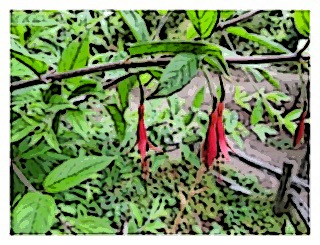
Seeds: Oblong-triangular, 2 to 2.6 mm long, 1 to 1.6 mm broad, and about 0.5 mm thick.
Chromosomes: Gametic chromosome number n = 22.
Authors—Berry 1989.
Original publication—Ann. Missouri Bot. Gard. 76: 552 1989.
Synonyms—None.
Herbaria—None on line.
Brazil. Found in the montane forests of the Serra de Paranapiacaba in southern São Paulo state, in the Serra da Virgem Maria and Rio Capivari drainage in Paraná state, and then on the lower most slopes of the Serra do Mar and in coastal restingas, from sea level to 900 meters.

The flowers occur throughout the year, but mainly during the summer season from November to March. Natural hybridization with F. regia subsp. serrae is known to occur
Habit—Scandent shrubs two to six meters tall, or occasionally lianas in trees to eight meters high, with basal stems 1 to 6 cm in diameter, branches scandent or drooping to three meters long. Young growth densely pilose to puberulent, older stems exfoliating.
Leaves—Opposite, ternate or occasionally in whorls of four, firmly membranous, lanceolate to narrowly ovate, 20 to 75 mm long, 10 to 25 (to 30) mm wide, acute to occasionally acuminate at the apex, rounded at the base, subglabrous to sparsely pubescent above with impressed veins, sparsely puberulent to villous below, especially along nerves; margin entire to remotely denticulate, secondary veins 3 to 6 per side. Petioles usually dull purple, (2 to) 4 to 8 (to 14) mm long, subglabrous to densely pilose.

Flowers—Solitary in upper leaf axils, pedicels pendulous, 17 to 28 (to 42) mm long, ovary oblong, 5 to 10 mm long, 2 to 4 mm wide, loosely pilose, green, floral tube subcylindric to fusiform, 7 to 10 mm long, 2 to 3 mm wide at the base, 3.5 to 4.5 mm wide in the middle, often constricted to about 3 mm wide at the point of insertion of the stamens beneath the widening of the sepal tube, glabrous to pilose outside, pilose inside, nectary green, slightly ridged, 1 to 1.2 mm thick and 2.5 to 3 mm high, sepals 17 to 25 mm long, connate for (8 to) 11 to 16 mm at the base and forming a tube, this enlarging to 8 to 10 mm wide before the separation of the sepals, the free lobes narrowly triangular, 5 to 11 (to 13) mm long, 3 to 5 mm wide at the base, acute to acuminate at the apex, spreading to slightly recurved at anthesis. Tube and sepals red to red-pink, petals almost entirely enclosed by the sepal tube, light to dark purple, spathulate, 12 to 18 mm long, (5 to) 6 to 7 mm wide, rounded at the apex, the base slender and adnate to the sepal tube in the basal 3 to 4 mm above the insertion of the filaments, filaments reddish pink, 22 to 38 mm and 19 to 35 mm long, anthers red-purple, oblong, 2.5 to 3 mm long, 1 to 1.5 mm wide, style reddish, pilose in lower half, stigma clavate, purple, 1.2 to 1.6 mm long, about 1 mm wide, exserted 5 to 10 mm beyond the anthers.
Fruit: The berry is oblong-ellipsoid, 15 to 22 (to 26) mm long and 7 to 10 (to 16) mm wide at maturity, black when ripe;

Seeds: Oblong-triangular, 2 to 2.6 mm long, 1 to 1.6 mm broad, and about 0.5 mm thick.
Chromosomes: Gametic chromosome number n = 22.
Authors—Berry 1989.
Original publication—Ann. Missouri Bot. Gard. 76: 552 1989.
Synonyms—None.
Herbaria—None on line.
F. campos-portoi Pilg. & C.K.Schulze
Brazil. Endemic to the open campos of the Itatiaia mountain massif, in the Serra da Mantiqueira, Rio de Janeiro and Minas Gerais border at elevations from 2,100 and 2,550 meters.
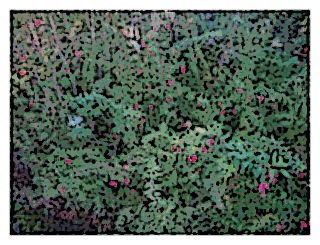
Flowers occur mainly during the summer, from November to March. Natural hybridization with F. regia ssp. regia is known to occur.
Habit—Subshrubs to woody scandent bushes one third to two to three meters tall, often growing among rocks. Young growth subglabrous to finely canescent or pilose. Older stems 1 to 4 cm thick, with flaky, coppery brown bark.
Leaves—Mostly ternate, occasionally opposite or four or five-whorled, firmly membranous, narrowly elliptic-lanceolate, 12 to 40 mm long, 2 to 6 (to 8) mm wide, narrowly acute at the apex, acute to cuneate at the base, dark green and subglabrous above, paler and mostly glabrous below or with villous hairs along veins and margins; margin gland-serrulate, with teeth angled towards the apex, secondary veins three to seven per side, at times inconspicuous; internodes short, mostly 10 to 16 mm long. Petioles (2 to) 3 to 8 mm long. Stipules 0.5 to 1 mm long, narrowly lanceolate or filiform, deciduous.
Flowers—Solitary in upper leafaxils, pedicels slender, pendulous, (4 to) 8 to 20 mm long, ovary oblong, 4 to 5 mm long, about 2 mm wide, strigose to strigillose, floral tube subrhombic, 4 to 6 mm long, 3.5 mm wide in the middle and about 2.5 mm wide at the base and summit, glabrous to strigose outside, glabrous inside, nectary 2.5 to 3 mm high, shallowly eight-lobed, sepals 12 to 20 mm long, lance-elliptic, connate for 3 to 5 mm at the base, free lobes 4 to 7 mm wide at base, spreading at anthesis, tube and sepals red to dark pink, petals violet, broadly obovate, 9 to 12 mm long, 7 to 8 mm wide, rounded to slightly retuse at the apex, filaments red, 15 to 28 and 13 to 25 mm long, anthers purple-red, elliptic-oblong, 1.5 to 2 mm long, 1 to 1.5 mm wide, style glabrous, exserted 5 to 10 mm beyond the anthers, stigma clavate,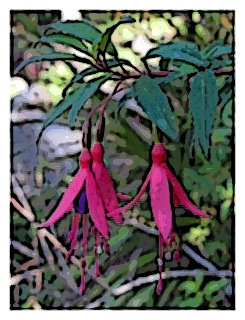 1.2 to 2 mm long, 0.7 to 0.9 mm wide.
1.2 to 2 mm long, 0.7 to 0.9 mm wide.
Fruit—The berry is cylindrical-oblong, 14 to 16 mm long and 7 to 8 mm thick.
Seeds—1.3 to 1.6 mm long and 0.7 to 1.1 mm wide.
Chromosomes—Gametic chromosome number n = 22.
Authors—Pilger & Schulze 1935. Berry 1989.
Original publication—Rodriguésia 1(2): 95 1935.
Synonyms—None.
Herbaria—New York; Paris 1, Paris 2, Paris 3.
Brazil. Endemic to the open campos of the Itatiaia mountain massif, in the Serra da Mantiqueira, Rio de Janeiro and Minas Gerais border at elevations from 2,100 and 2,550 meters.

Flowers occur mainly during the summer, from November to March. Natural hybridization with F. regia ssp. regia is known to occur.
Habit—Subshrubs to woody scandent bushes one third to two to three meters tall, often growing among rocks. Young growth subglabrous to finely canescent or pilose. Older stems 1 to 4 cm thick, with flaky, coppery brown bark.
Leaves—Mostly ternate, occasionally opposite or four or five-whorled, firmly membranous, narrowly elliptic-lanceolate, 12 to 40 mm long, 2 to 6 (to 8) mm wide, narrowly acute at the apex, acute to cuneate at the base, dark green and subglabrous above, paler and mostly glabrous below or with villous hairs along veins and margins; margin gland-serrulate, with teeth angled towards the apex, secondary veins three to seven per side, at times inconspicuous; internodes short, mostly 10 to 16 mm long. Petioles (2 to) 3 to 8 mm long. Stipules 0.5 to 1 mm long, narrowly lanceolate or filiform, deciduous.
Flowers—Solitary in upper leafaxils, pedicels slender, pendulous, (4 to) 8 to 20 mm long, ovary oblong, 4 to 5 mm long, about 2 mm wide, strigose to strigillose, floral tube subrhombic, 4 to 6 mm long, 3.5 mm wide in the middle and about 2.5 mm wide at the base and summit, glabrous to strigose outside, glabrous inside, nectary 2.5 to 3 mm high, shallowly eight-lobed, sepals 12 to 20 mm long, lance-elliptic, connate for 3 to 5 mm at the base, free lobes 4 to 7 mm wide at base, spreading at anthesis, tube and sepals red to dark pink, petals violet, broadly obovate, 9 to 12 mm long, 7 to 8 mm wide, rounded to slightly retuse at the apex, filaments red, 15 to 28 and 13 to 25 mm long, anthers purple-red, elliptic-oblong, 1.5 to 2 mm long, 1 to 1.5 mm wide, style glabrous, exserted 5 to 10 mm beyond the anthers, stigma clavate,

Fruit—The berry is cylindrical-oblong, 14 to 16 mm long and 7 to 8 mm thick.
Seeds—1.3 to 1.6 mm long and 0.7 to 1.1 mm wide.
Chromosomes—Gametic chromosome number n = 22.
Authors—Pilger & Schulze 1935. Berry 1989.
Original publication—Rodriguésia 1(2): 95 1935.
Synonyms—None.
Herbaria—New York; Paris 1, Paris 2, Paris 3.
F. coccinea Aiton
Brazil. Occurring in rocky, open campos near the summits of several of the highest mountains in Minas Gerais—Serra da Piedade, Serra da Caraça, Serra do Itacolomi, and Pico do Itambé—at elevations from 1,400 to 2,000 meters.

Flowering is throughout the year, mainly from November to March. Natural hybridization with F. regia ssp. regia is known to occur.
Habit—Erect shrubs one half to one and a half meters tall, or scandent to seven meters high, often with extensive underground stems. Young growth is puberulent to densely pilose, older stems, 5 to 20 mm thick, with exfoliating bark.
Leaves—Mostly ternate, sometimes opposite or in fours, membranous or rarely subcoriaceous, narrowly ovate to ovate, 15 to 55 mm long, 7 to 25 mm wide, acute to subacuminate at the apex, subcordate or sometimes rounded at the base, generally dull, light green, paler below, sometimes strongly purpleflushed, subglabrous to puberulent on both sides, but generally densely pilose along the basal third of the midvein below; margins serrulate or occasionally subentire, secondary veins 4 to 6 per side, petioles short and stout, about 1 mm thick, 1 to 3 mm long, occasionally longer on basal leaves, usually densely pilose or hirsute. Stipules narrowly lanceolate, 0.8 to 1.4 mm long, deciduous.
Flowers—Solitary in the upper leafaxils, pedicels slender, pubescent 18 to 42 (to 50) mm long, divergent or arching from the stems and pendent only in the distal third, ovary oblong-ellipsoid, 5 to 9 mm long, 2.5 to 3 mm thick, floral tube fusiform, 5 to 10 mm long, 2.5 to 3 mm wide at the base, 3.5 to 4.5 mm wide in the middle and 3 to 4 mm wide at the top, sub glabrous to puberulent outside, puberulent inside, nectary smooth, 2 to 3 mm high, sepals 15 to 24 mm long, oblong-lanceolate, lightly pubescent, connate at the base for 4 to 7 mm, free lobes 3.5 to 6 mm wide, acute at the apex, spreading at anthesis. tube and sepals red to dark pink, petals violet, obovate, 7 to 10 mm long, 6 to 8 (to 9) mm wide, filaments red-purple, 18 to 38 mm and 13 to 30 mm long, anthers purplish, 22.5 mm long, about 1.5 mm wide, style puberulent, red, stigma clavate, 1.5 to 2 mm long, exserted sIS mm beyond the anthers.
Fruit—Mature berry ellipsoid, 14 to 17 mm long, about 12 mm thick, and purple.
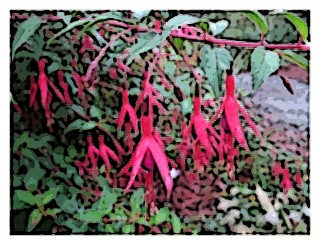
Seeds—Oblong-triangular, 1.4 to 1.9 mm long and 0.8 to 1.2 mm wide.
Chromosomes: Gametic chromosome number n = 22.
Authors—Dryander 1789. Berry 1989.
Original publication—Hort. Kew. 2: 8 1789.
Synonyms—Fuchsia elegans, Salisbury 1791; Fuchsia pendula, Salisbury 1796; Nahusia coccinea, (Dryander) Schneevoogt 1792; Fuchsia montana, Cambessedes 1830.
Herbaria—Berlin; New York.
Brazil. Occurring in rocky, open campos near the summits of several of the highest mountains in Minas Gerais—Serra da Piedade, Serra da Caraça, Serra do Itacolomi, and Pico do Itambé—at elevations from 1,400 to 2,000 meters.

Flowering is throughout the year, mainly from November to March. Natural hybridization with F. regia ssp. regia is known to occur.
Habit—Erect shrubs one half to one and a half meters tall, or scandent to seven meters high, often with extensive underground stems. Young growth is puberulent to densely pilose, older stems, 5 to 20 mm thick, with exfoliating bark.
Leaves—Mostly ternate, sometimes opposite or in fours, membranous or rarely subcoriaceous, narrowly ovate to ovate, 15 to 55 mm long, 7 to 25 mm wide, acute to subacuminate at the apex, subcordate or sometimes rounded at the base, generally dull, light green, paler below, sometimes strongly purpleflushed, subglabrous to puberulent on both sides, but generally densely pilose along the basal third of the midvein below; margins serrulate or occasionally subentire, secondary veins 4 to 6 per side, petioles short and stout, about 1 mm thick, 1 to 3 mm long, occasionally longer on basal leaves, usually densely pilose or hirsute. Stipules narrowly lanceolate, 0.8 to 1.4 mm long, deciduous.
Flowers—Solitary in the upper leafaxils, pedicels slender, pubescent 18 to 42 (to 50) mm long, divergent or arching from the stems and pendent only in the distal third, ovary oblong-ellipsoid, 5 to 9 mm long, 2.5 to 3 mm thick, floral tube fusiform, 5 to 10 mm long, 2.5 to 3 mm wide at the base, 3.5 to 4.5 mm wide in the middle and 3 to 4 mm wide at the top, sub glabrous to puberulent outside, puberulent inside, nectary smooth, 2 to 3 mm high, sepals 15 to 24 mm long, oblong-lanceolate, lightly pubescent, connate at the base for 4 to 7 mm, free lobes 3.5 to 6 mm wide, acute at the apex, spreading at anthesis. tube and sepals red to dark pink, petals violet, obovate, 7 to 10 mm long, 6 to 8 (to 9) mm wide, filaments red-purple, 18 to 38 mm and 13 to 30 mm long, anthers purplish, 22.5 mm long, about 1.5 mm wide, style puberulent, red, stigma clavate, 1.5 to 2 mm long, exserted sIS mm beyond the anthers.
Fruit—Mature berry ellipsoid, 14 to 17 mm long, about 12 mm thick, and purple.

Seeds—Oblong-triangular, 1.4 to 1.9 mm long and 0.8 to 1.2 mm wide.
Chromosomes: Gametic chromosome number n = 22.
Authors—Dryander 1789. Berry 1989.
Original publication—Hort. Kew. 2: 8 1789.
Synonyms—Fuchsia elegans, Salisbury 1791; Fuchsia pendula, Salisbury 1796; Nahusia coccinea, (Dryander) Schneevoogt 1792; Fuchsia montana, Cambessedes 1830.
Herbaria—Berlin; New York.
F. glazioviana Taub.
Brazil. Occurring in open campo and in cloud forest on a few high mountains around the towns of Nova Friburgo and Santa Maria Madalena, in Rio de Janeiro state at elevations from 1,500 to 2,100 meters.
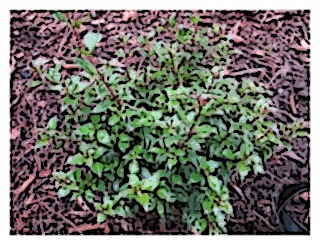
Flowering is throughout the year, but mainly from November to March. Natural hybridization with F. regia ssp. regia is known to occur.
Habit—Shrubs one half to four meters high, often scandent in trees or low brush and with decumbent branches to six meters long, branchlets subdivaricate and generally densely packed, minutely puberulent, dull purplish, readily exfoliating.
Leaves—Opposite or ternate, firmly membranous to subcoriaceous, elliptic or lanceolate, 15 to 30 (to 40) mm long, 8 to 15 mm wide, acute at the base and apex, dark sublustrous green and glabrous above, paler and subglabrous below or sometimes pilose at the base of the midvein; margins remotely gland-denticulate, with 4 to 5 (to 6) secondary veins per side, petioles 3 to 6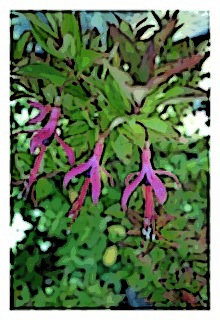 mm long, purplish and sparsely puberulent, internodes short, 3 to 12 mm long, stipules broadly triangular, 0.6 to 1.2 mm long and wide, thick at the base, purplish, deciduous.
mm long, purplish and sparsely puberulent, internodes short, 3 to 12 mm long, stipules broadly triangular, 0.6 to 1.2 mm long and wide, thick at the base, purplish, deciduous.
Flowers—Solitary in the upper leafaxils, pedicels slender, sparsely puberulent, pendulous, 12 to 26 mm long, ovary oblong, 4 to 5 mm long, 2 to 2.5 mm wide, floral tube cylindrical, 5 to 7 mm long, 2.5 to 4 mm wide, subglabrous outside, glabrous inside, nectary smooth, 3 to 4 mm high, sepals 17 to 22 mm long, narrowly lanceolate, connate at the base for 4 to 5 mm, free lobes 3-4 mm wide, acuminate at the apex, spreading at anthesis, tube and sepals red or pink, petals purple, obovate, 9 to 12 mm long, 6 to 9 mm wide, rounded at the apex, filaments red-purple, 22 to 32 and 16- to 8 mm long, anthers oblong, 2.5 to 3.5 mm long, 1.1 to 1.6 mm wide, style red, glabrous to puberulent, stigma clavate, 2 to 3 mm long and 1 to 1.4 mm wide, exserted 5 to 20 mm beyond the anthers.
Fruit—The berry is subcylindrical, 10 to 16 mm long, 5 to 8 mm wide and shiny dark purple.
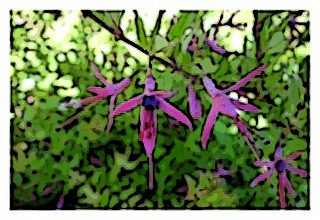 Seeds—Oblong, 2 to 4 mm long and 1 to 1.5 mm wide.
Seeds—Oblong, 2 to 4 mm long and 1 to 1.5 mm wide.
ChromosomesGametic chromosome number n = 22.
Authors—Taubert 1892. Berry 1989.
Original publication—Bot. Jahrb. Syst. 15(34): 16 1892.
Synonyms—Fuchsia santos-limae, Brade 1957.
Herbaria—Kew.
Brazil. Occurring in open campo and in cloud forest on a few high mountains around the towns of Nova Friburgo and Santa Maria Madalena, in Rio de Janeiro state at elevations from 1,500 to 2,100 meters.

Flowering is throughout the year, but mainly from November to March. Natural hybridization with F. regia ssp. regia is known to occur.
Habit—Shrubs one half to four meters high, often scandent in trees or low brush and with decumbent branches to six meters long, branchlets subdivaricate and generally densely packed, minutely puberulent, dull purplish, readily exfoliating.
Leaves—Opposite or ternate, firmly membranous to subcoriaceous, elliptic or lanceolate, 15 to 30 (to 40) mm long, 8 to 15 mm wide, acute at the base and apex, dark sublustrous green and glabrous above, paler and subglabrous below or sometimes pilose at the base of the midvein; margins remotely gland-denticulate, with 4 to 5 (to 6) secondary veins per side, petioles 3 to 6

Flowers—Solitary in the upper leafaxils, pedicels slender, sparsely puberulent, pendulous, 12 to 26 mm long, ovary oblong, 4 to 5 mm long, 2 to 2.5 mm wide, floral tube cylindrical, 5 to 7 mm long, 2.5 to 4 mm wide, subglabrous outside, glabrous inside, nectary smooth, 3 to 4 mm high, sepals 17 to 22 mm long, narrowly lanceolate, connate at the base for 4 to 5 mm, free lobes 3-4 mm wide, acuminate at the apex, spreading at anthesis, tube and sepals red or pink, petals purple, obovate, 9 to 12 mm long, 6 to 9 mm wide, rounded at the apex, filaments red-purple, 22 to 32 and 16- to 8 mm long, anthers oblong, 2.5 to 3.5 mm long, 1.1 to 1.6 mm wide, style red, glabrous to puberulent, stigma clavate, 2 to 3 mm long and 1 to 1.4 mm wide, exserted 5 to 20 mm beyond the anthers.
Fruit—The berry is subcylindrical, 10 to 16 mm long, 5 to 8 mm wide and shiny dark purple.

ChromosomesGametic chromosome number n = 22.
Authors—Taubert 1892. Berry 1989.
Original publication—Bot. Jahrb. Syst. 15(34): 16 1892.
Synonyms—Fuchsia santos-limae, Brade 1957.
Herbaria—Kew.
F. hatschbachii P.E.Berry
Brazil. Occurring in low forests on limestone or sandstone outcrops, in the planalto to the north and west of Curitiba, Paraná at elevations from 950 to 1,150 meters.
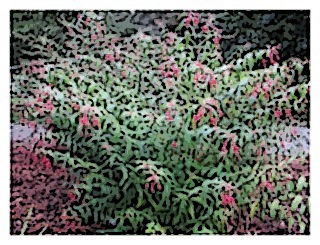
Flowers occur mainly from November to March.
Habit—Erect to scandent shrubs one to three meters tall or climbers in trees to five meters above ground, branchlets glabrous, dull purple, older branches ascending on small shrubs or decumbent in large or climbing plants.
Leaves—Mostly opposite, occasionally in whorls of three to four, firmly membranous to subcoriaceous, narrowly lance-ovate, generally three times longer than wide, 3 to 7.5 (to 11.0) cm long, 0.8 to 2.5 (to 3.0) cm side, apex attenuate to acuminate, base rounded to narrowly subcordate, sublustrous dark green above, pale below and glabrous on both sides except for small tufts of hairs 0.8 to 1 mm long at the base of the lower midvein in some plants, margin remotely gland-denticulate, secondary veins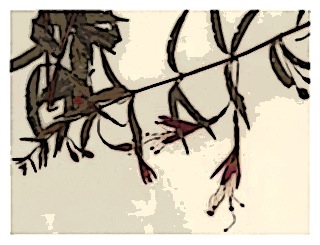 5-6(-7) per side, petioles wine purple, (2 to) 3 to 6 (to7) mm long, 1 to 2 mm thick, canaliculate above, at times making a marked angle at the junction with the midvein, stipules narrowly triangular, 1 to 1.7 mm long, 0.6 to 1.2 mm wide, adjacent ones occasionally fused, semideciduous.
5-6(-7) per side, petioles wine purple, (2 to) 3 to 6 (to7) mm long, 1 to 2 mm thick, canaliculate above, at times making a marked angle at the junction with the midvein, stipules narrowly triangular, 1 to 1.7 mm long, 0.6 to 1.2 mm wide, adjacent ones occasionally fused, semideciduous.
Flowers—Glabrous and solitary in upper leafaxils, pedicels pendulous, (10 to) 20 to 30 mm long, ovary cylindrical, 5 to 9 mm long, 2.5 to 3 mm wide, floral tube cylindrical, 10 to 15 mm long, 3 to 5 mm wide, nectary 3 to 5 mm high, sepals 18-26 mm long, connate at the base for 2-6 mm, free lobes 3.5 to 5 mm wide at the base, spreading at anthesis. tube and sepals red, petals violet, broadly obovate, 12 to 17 mm long, 8 to 12 mm wide, filaments red, 40 to 45 mm and 32 to 40 mm long, anthers red-purple, 3 to 3.5 mm long, 1 to 1.5 mm wide, style red, loosely pilose in lower half, stigma 2 to 3 mm long, 1 to 1.5 mm wide, exserted 15 to 20 mm beyond the anthers.
Fruit—The berry is subcylindrical, more-or-less four-angled, 13 to 18 mm long, 7 to 10 mm thick, and purple when ripe.
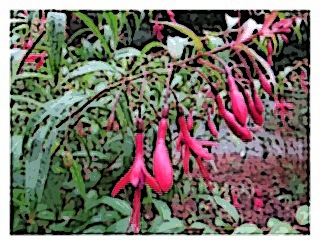
Seeds—Oblong-triangular, 1.4 to 1.8 mm long and 0.8- to .2 mm wide.
Chromosomes—Gametic chromosome number n = 22.
Authors—Berry 1989.
Original publication—Ann. Missouri Bot. Gard. 76: 559 1989.
Synonyms—None.
Herbaria—Kew 1, Kew 2; MIssouri 1, Missouri 2; New York; Smithsonian.
Brazil. Occurring in low forests on limestone or sandstone outcrops, in the planalto to the north and west of Curitiba, Paraná at elevations from 950 to 1,150 meters.

Flowers occur mainly from November to March.
Habit—Erect to scandent shrubs one to three meters tall or climbers in trees to five meters above ground, branchlets glabrous, dull purple, older branches ascending on small shrubs or decumbent in large or climbing plants.
Leaves—Mostly opposite, occasionally in whorls of three to four, firmly membranous to subcoriaceous, narrowly lance-ovate, generally three times longer than wide, 3 to 7.5 (to 11.0) cm long, 0.8 to 2.5 (to 3.0) cm side, apex attenuate to acuminate, base rounded to narrowly subcordate, sublustrous dark green above, pale below and glabrous on both sides except for small tufts of hairs 0.8 to 1 mm long at the base of the lower midvein in some plants, margin remotely gland-denticulate, secondary veins

Flowers—Glabrous and solitary in upper leafaxils, pedicels pendulous, (10 to) 20 to 30 mm long, ovary cylindrical, 5 to 9 mm long, 2.5 to 3 mm wide, floral tube cylindrical, 10 to 15 mm long, 3 to 5 mm wide, nectary 3 to 5 mm high, sepals 18-26 mm long, connate at the base for 2-6 mm, free lobes 3.5 to 5 mm wide at the base, spreading at anthesis. tube and sepals red, petals violet, broadly obovate, 12 to 17 mm long, 8 to 12 mm wide, filaments red, 40 to 45 mm and 32 to 40 mm long, anthers red-purple, 3 to 3.5 mm long, 1 to 1.5 mm wide, style red, loosely pilose in lower half, stigma 2 to 3 mm long, 1 to 1.5 mm wide, exserted 15 to 20 mm beyond the anthers.
Fruit—The berry is subcylindrical, more-or-less four-angled, 13 to 18 mm long, 7 to 10 mm thick, and purple when ripe.

Seeds—Oblong-triangular, 1.4 to 1.8 mm long and 0.8- to .2 mm wide.
Chromosomes—Gametic chromosome number n = 22.
Authors—Berry 1989.
Original publication—Ann. Missouri Bot. Gard. 76: 559 1989.
Synonyms—None.
Herbaria—Kew 1, Kew 2; MIssouri 1, Missouri 2; New York; Smithsonian.
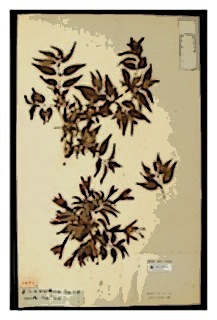
Southern Chile & Argentina. In moist scrub and along forest margins, especially near water, throughout the central and southern Andes of Chile and Argentina and in coastal Chile, from Valparaíso, Chile (32°50’ S) and Neuquén, Argentina (39°30’ S) to the southernTierra del Fuego (55° S, historically to 64° W) at elevations from sea level, throughout its range, to 1,750 meters in Central Chile near Santiago. It is geographically separated from the other eight species in this section by 1,000 to 1,500 kilometers.
This is a very variable species throughout the whole of its native range, even occasionally throwing very pale pink-flowered individuals, and there are currently no validly recognized varieties or subspecies. At the far northern edge of its range, F. magellanica forms interspecific hybrids with F. lycioides.
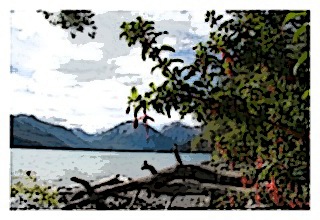
F. magellanica is widely cultivated and has naturalized itself in parts of South America, East Africa, New Zealand, Ireland and Hawaii. The many so-called "varieties" commonly found in cultivation, however, have almost all been determined to be hybrids and should always be expressed as garden selections or cultivars.
Flowering is from December to March, but occasionally starts as early as October and can continue to as late as April.
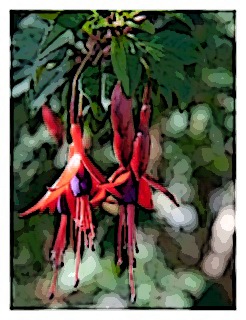
Habit—Small shrubs, stems long, arcuate, one to two and a half (to four) meters long.
Leaves—In whorls of three to four per node or sometimes opposite, ovate to lanceolate, 2.5 to 6 cm long, 1 to 2 cm wide, margins serrate, petioles 0.5 to 1 cm long.
Flowers—Flowers perfect, axillary and pendent, peduncles 3 to 4.5 cm long, floral tube magenta, 10 to 13 mm long, sepals magenta, 20 to 25 mm long, petals dark purple, convolute after anthesis, 10 to 13 mm long, stamens exserted, filaments 25 to 30 mm long.
Fruit—The berries are ellipsoid and 10 to 15 mm long.
Chromosomes: Gametic chromosomes number 2n = 22, 44
Authors—Lamarck 1788. Berry 1989.
Original publication—Encycl. 2: 564 1788.
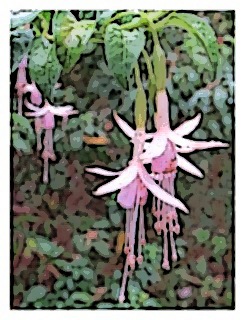
Herbaria—Austral Americano; Arizona State 1, Arizona State 2; Field Museum; Kew 1 (as discolor), Kew 2 (as discolor), Kew 3 (as gracilis); New York 1, New York 2, New York 3, New York 4; Paris (type); Smithsonian.
(Illustrations: 1. F. magellanica growing natively in the Patagonian Lake District; 2. Pale-flowered variation; 3. Native F. magellanica on the shore of Lago Moscardi in the Argentine Andes; 4. Type specimen of F. magellanica used by Lamarck to describe the species in 1788.)
F. regia (3 subspecies)
Authors—Vellozo 1943.
Original publication—Proc. Calif. Acad. Sci. IV, 25: 13 1943.
Authors—Vellozo 1943.
Original publication—Proc. Calif. Acad. Sci. IV, 25: 13 1943.
F. regia subsp. regia (Vand. ex Vell.) Munz
Brazil. Found in the montane cloud forests of the Serra do Mar, Serra do Caparaó, Serra do Espinhaço, Serra da Caraça, Serra da Mantiqueira, Serra da Bocaina, and other subsidiary mountain ranges in Espírito Santo, Minas Gerais, Rio de Janeiro, and northern São Paulo states at elevations from 1,000 to 2,400 meters. This is a shrub 0.5 to 5 meters tall, occasionally erect but usually scandent, or a liana in trees to 15 meters tall.
Flowering is mainly from October to April.
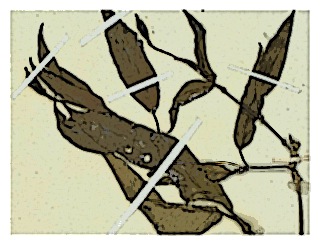
Habit—Shrubs one half to five meters tall, occasionally erect but usually scandent, or lianas to fifteen meters high in trees. Branchlets generally glaucous and wine purple, occasionally loosely to densely pilose, older plants with long hanging branches to five meters long.
Leaves—Opposite, or in whorls of three and four, subcoriaceous, elliptic to lance-elliptic or ovate, 40 to 140 mm long, 10 to 50 (to 70) mm wide, apex acute to acuminate, base acute to cuneate or rounded, sublustrous green and glabrous to pubescent above, veins often reddish tinged, paler green and glabrous to pilose below, sometimes with tufts of pilose hairs at the base of the lower midvein; margin subentire to remotely gland-denticulate, secondary veins 6 to 9 (to 10) per side. Petioles stout, 2 to 3 mm thick, canaliculate above, (6 to) 10 to 28 mm long, wine purple. Stipules triangular, membranous or thickened at the base, ± recurved, 0.9 to 2 (to 3) mm long, 0.5 to 1.8 mm wide, adjacent ones sometimes fused, the base usually persistent but the tip deciduous.
Flowers—Solitary in the upper leaf axils, pedicels 22 to 55 mm long, pendulous, ovary cylindrical, 6 to 11 mm long, 34 mm thick, floral tube narrowly to broadly cylindrical- fusiform, 10 to 16 mm long, 4 to 6 mm wide, glabrous to subpilose outside, nectary smooth to ridged, 5 to 8 mm high, sepals 24 to 45 mm long, narrowly lanceolate, connate at the base for 3 to 7 mm, free lobes 4 to 9 mm wide at base, spreading at anthesis. Tube and sepals red to rose, petals violet,obovate, 13 to 22 mm long, 10 to 16 mm wide, filaments red-purple, 25 to 44 mm and 23 to 38 mm long, anthers oblong, 3 to 5 mm long, 1.5 to 2 mm wide, style glabrous to pilose in lower half, stigma red, narrowly clavate, 3.5 to 6 mm long, 1.2 to 1.6 mm thick, exserted 10 to 27 mm beyond the anthers when fully extended.
Fruit—The berry is oblong-ellipsoid, 20 to 25 mm long, 9 to 12 mm thick and purple when ripe.
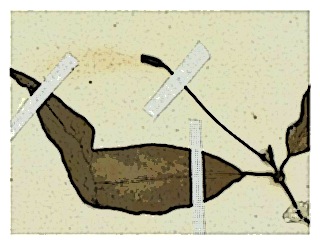
Seeds—1.8 to 2.8 mm long and 1.2 to 1.8 mm wide.
Chromosomes—Gametic chromosome numbers n = 22, 44
Authors—Berry 1989.
Original publication—Proc. Calif. Acad. Sci. IV, 25: 13 1943.
Synonyms—F. integrifolia, Cambessedes 1830; F. pyrifolia, Presl 1834; F. regia var. typica, Munz 1943.
Herbarium Specimens—Smithsonian 1; Smithsonian 2.
Brazil. Found in the montane cloud forests of the Serra do Mar, Serra do Caparaó, Serra do Espinhaço, Serra da Caraça, Serra da Mantiqueira, Serra da Bocaina, and other subsidiary mountain ranges in Espírito Santo, Minas Gerais, Rio de Janeiro, and northern São Paulo states at elevations from 1,000 to 2,400 meters. This is a shrub 0.5 to 5 meters tall, occasionally erect but usually scandent, or a liana in trees to 15 meters tall.
Flowering is mainly from October to April.

Habit—Shrubs one half to five meters tall, occasionally erect but usually scandent, or lianas to fifteen meters high in trees. Branchlets generally glaucous and wine purple, occasionally loosely to densely pilose, older plants with long hanging branches to five meters long.
Leaves—Opposite, or in whorls of three and four, subcoriaceous, elliptic to lance-elliptic or ovate, 40 to 140 mm long, 10 to 50 (to 70) mm wide, apex acute to acuminate, base acute to cuneate or rounded, sublustrous green and glabrous to pubescent above, veins often reddish tinged, paler green and glabrous to pilose below, sometimes with tufts of pilose hairs at the base of the lower midvein; margin subentire to remotely gland-denticulate, secondary veins 6 to 9 (to 10) per side. Petioles stout, 2 to 3 mm thick, canaliculate above, (6 to) 10 to 28 mm long, wine purple. Stipules triangular, membranous or thickened at the base, ± recurved, 0.9 to 2 (to 3) mm long, 0.5 to 1.8 mm wide, adjacent ones sometimes fused, the base usually persistent but the tip deciduous.
Flowers—Solitary in the upper leaf axils, pedicels 22 to 55 mm long, pendulous, ovary cylindrical, 6 to 11 mm long, 34 mm thick, floral tube narrowly to broadly cylindrical- fusiform, 10 to 16 mm long, 4 to 6 mm wide, glabrous to subpilose outside, nectary smooth to ridged, 5 to 8 mm high, sepals 24 to 45 mm long, narrowly lanceolate, connate at the base for 3 to 7 mm, free lobes 4 to 9 mm wide at base, spreading at anthesis. Tube and sepals red to rose, petals violet,obovate, 13 to 22 mm long, 10 to 16 mm wide, filaments red-purple, 25 to 44 mm and 23 to 38 mm long, anthers oblong, 3 to 5 mm long, 1.5 to 2 mm wide, style glabrous to pilose in lower half, stigma red, narrowly clavate, 3.5 to 6 mm long, 1.2 to 1.6 mm thick, exserted 10 to 27 mm beyond the anthers when fully extended.
Fruit—The berry is oblong-ellipsoid, 20 to 25 mm long, 9 to 12 mm thick and purple when ripe.

Seeds—1.8 to 2.8 mm long and 1.2 to 1.8 mm wide.
Chromosomes—Gametic chromosome numbers n = 22, 44
Authors—Berry 1989.
Original publication—Proc. Calif. Acad. Sci. IV, 25: 13 1943.
Synonyms—F. integrifolia, Cambessedes 1830; F. pyrifolia, Presl 1834; F. regia var. typica, Munz 1943.
Herbarium Specimens—Smithsonian 1; Smithsonian 2.
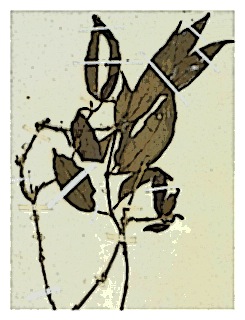


F. regia subsp. reitzii P.E.Berry
Brazil. Occurring principally in low wooded areas and usually along streams or seepages, on the planalto west of the Serra Geral and Serra do Mar in south-central Paraná, Santa Catarina, and Rio Grande do Sul at elevations from 800 to 1,750 meters.
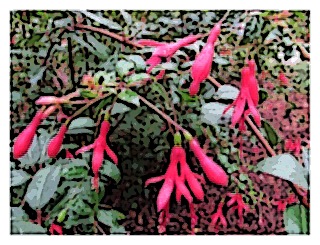
Flowering is mainly from November to March. At the top of the escarpments of the coastal mountain ranges this subspecies intergrades with F. regia subsp. serrae.
Habit—Erect to scandent shrubs one to three meters high, or climbers in trees or brush to four meters tall, young branches purplish, subglabrous to densely puberulent or pilose, the pubescence ferrugineous in some plants, older stems with reddish to pale tan, readily exfoliating bark.
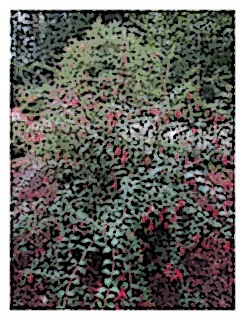
Leaves—In whorls of three or for to five, firmly membranous, (narrowly) elliptic to narrowly ovateelliptic, 20 to 65 (to 90) mm long, 7 to 20 (to 40) mm wide, acute at the apex, acute to attenuate or obtuse at the base, dark dull green and sub glabrous above, pale green and subglabrous to densely pubescent below with conspicuous tertiary venation, margin serrulate, usually with prominent glandular teeth ascending apically at a more-or-less 45 degree angle, secondary veins 5 to 8 per side, petioles 3 to 7 (to 15) mm long. Stipules lanceolate, 0.8 to 1.4 mm long, 0.4 to 1 mm wide, thick at the base, purple, drying dark, divergent to recurved with age, with apiculate, semipersistent tips.
Flowers:—Flowers solitary or sometimes two per leaf axil, near branch tips, pedicels slender, 10 to 35 (to 50) mm long,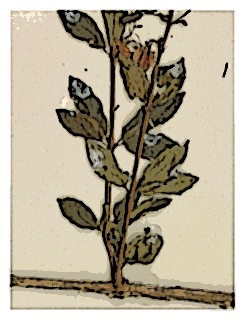 pendulous, ovary oblong, (4 to) 5 to 9 mm long, 2 to 4 mm wide, floral tube cylindricalfusiform, 5 to 9 (to 11) mm long, 2 to 4 (to 6) mm wide, sub glabrous to puberulent or loosely pilose outside, glabrous inside, nectary smooth, 2.5 to 5 mm high, sepals 17 to 28 mm long, narrowly lance-oblong, connate at the base for 2 to 6 mm, free lobes 3 to 5 (to 6) mm wide at base, subacuminate at the apex, spreading at anthesis. Tube and sepals red, petals purple,obovate, 10 to 15 (to 20) mm long, 7 to 13 mm wide, filaments reddish, 25 to 45 mm and 20 to 38 mm long, anthers red-purple, oblong-elliptic, 2 to 2.5 mm long, 1 to 1.5 mm wide, style glabrous to pilose in lower half, stigma clavate, 2 to 2.5 mm long, 1 to 1.5 mm wide, exserted 5 to 15 mm beyond the anthers.
pendulous, ovary oblong, (4 to) 5 to 9 mm long, 2 to 4 mm wide, floral tube cylindricalfusiform, 5 to 9 (to 11) mm long, 2 to 4 (to 6) mm wide, sub glabrous to puberulent or loosely pilose outside, glabrous inside, nectary smooth, 2.5 to 5 mm high, sepals 17 to 28 mm long, narrowly lance-oblong, connate at the base for 2 to 6 mm, free lobes 3 to 5 (to 6) mm wide at base, subacuminate at the apex, spreading at anthesis. Tube and sepals red, petals purple,obovate, 10 to 15 (to 20) mm long, 7 to 13 mm wide, filaments reddish, 25 to 45 mm and 20 to 38 mm long, anthers red-purple, oblong-elliptic, 2 to 2.5 mm long, 1 to 1.5 mm wide, style glabrous to pilose in lower half, stigma clavate, 2 to 2.5 mm long, 1 to 1.5 mm wide, exserted 5 to 15 mm beyond the anthers.
Fruit—The berry is globose to ellipsoid, (10 to) 12 to 16 mm long, 9 to 12 mm wide, and shiny dark purple when ripe.
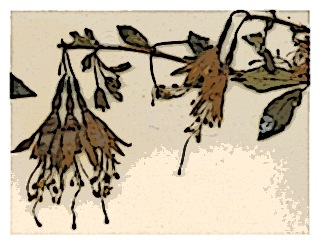
Seeds—Tan, 1.6 to 2 mm long and 1 to 1.3 mm wide.
Chromosomes—Gametic chromosome number n = 44.
Authors—Berry 1989.
Original publication—Ann. Missouri Bot. Gard. 76: 577 1989.
Synonyms—F. pubescens, Cambessedes 1839.
Herbaria—Kew; New York 1, New York 2; Paris.
Brazil. Occurring principally in low wooded areas and usually along streams or seepages, on the planalto west of the Serra Geral and Serra do Mar in south-central Paraná, Santa Catarina, and Rio Grande do Sul at elevations from 800 to 1,750 meters.

Flowering is mainly from November to March. At the top of the escarpments of the coastal mountain ranges this subspecies intergrades with F. regia subsp. serrae.
Habit—Erect to scandent shrubs one to three meters high, or climbers in trees or brush to four meters tall, young branches purplish, subglabrous to densely puberulent or pilose, the pubescence ferrugineous in some plants, older stems with reddish to pale tan, readily exfoliating bark.

Leaves—In whorls of three or for to five, firmly membranous, (narrowly) elliptic to narrowly ovateelliptic, 20 to 65 (to 90) mm long, 7 to 20 (to 40) mm wide, acute at the apex, acute to attenuate or obtuse at the base, dark dull green and sub glabrous above, pale green and subglabrous to densely pubescent below with conspicuous tertiary venation, margin serrulate, usually with prominent glandular teeth ascending apically at a more-or-less 45 degree angle, secondary veins 5 to 8 per side, petioles 3 to 7 (to 15) mm long. Stipules lanceolate, 0.8 to 1.4 mm long, 0.4 to 1 mm wide, thick at the base, purple, drying dark, divergent to recurved with age, with apiculate, semipersistent tips.
Flowers:—Flowers solitary or sometimes two per leaf axil, near branch tips, pedicels slender, 10 to 35 (to 50) mm long,

Fruit—The berry is globose to ellipsoid, (10 to) 12 to 16 mm long, 9 to 12 mm wide, and shiny dark purple when ripe.

Seeds—Tan, 1.6 to 2 mm long and 1 to 1.3 mm wide.
Chromosomes—Gametic chromosome number n = 44.
Authors—Berry 1989.
Original publication—Ann. Missouri Bot. Gard. 76: 577 1989.
Synonyms—F. pubescens, Cambessedes 1839.
Herbaria—Kew; New York 1, New York 2; Paris.

Brazil. Scandent to climbing in high trees typical of the dense cloud forests on the crest and wet, coastal escarpments of the Serra do Mar and Serra Geral, in Rio Grande do Sul, Santa Catarina, Paraná, São Paulo and southern Rio de Janeiro States at elevations from 500 to 1,450 meters. It is also found at lower elevations on the top of isolated morros in the Atlantic coastal forest of Santa Catarina, or rarely occurs near sea level in coastal resting as in northern Rio Grande do Sul and southern Santa Catarina.
Flowering is mainly from November to March, occasionally in other months. Natural hybridization with F. brevilobis, F. regia subsp. regia and F. regia subsp. reitzii is known to occur.

Leaves—Opposite or in whorls of three to four, coriaceous, (narrowly) ovate to elliptic, (35 to) 60 to 110 mm long, (15 to) 25 to 45 mm wide, apex acute to acuminate, base rounded to acute and sometimes ± uneven, smooth and lustrous dark green above, pale below, glabrous to lightly pubescent on both surfaces; margin subentire, secondary veins 5 to 8 (to 10) per side. Petioles 1.5 to 3 mm thick, usually dull purple, canaliculate above, (7 to)10 to 24 (to 35) mm long. Stipules prominent, crassate, 2 to 3 mm wide, 2 to 3 mm long, about 0.5 mm thick, recurved, persistent, adjacent ones sometimes fused, drying tan-colored and giving a nodose appearance to the stems.
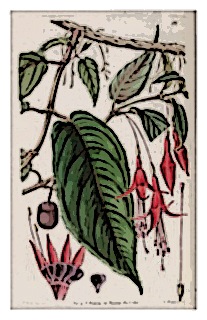
Fruit—The berry is oblong, 16 to 26 mm long, 9 to 13 mm thick, and purple when ripe.
Seeds—2 to 2.5 mm long and 11.5 mm wide.
Chromosomes: Gametic chromosome number n = 44.
Authors—Berry 1989.
Original publication—Ann. Missouri Bot. Gard. 76: 577 1989.
Synonyms—F. affinis, Cambessedes 1830; F. radicans, Miers 1841; F. regia var. affinis, (Cambessedes) Munz 1943; F. regia var. radicans, (Miers) Munz 1943.
Herbaria—Kew; MIssouri 1, Missouri 2; New York.
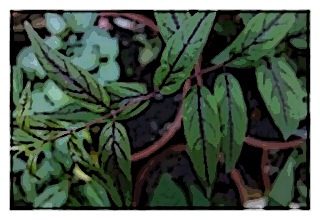
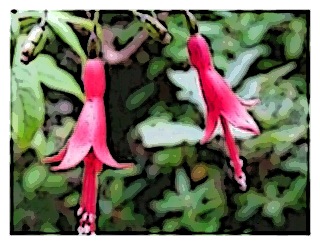
According to Dr. Paul E. Berry, professor, director and curator at the University of Michigan's Herbarium and the world's leading scientific authority currently working on the genus, he may recognize an additional subspecies or variety as F. regia subsp. radicans or F. regia var. radicans in a future publication. F. radicans was originally described by Miers in 1841 but rendered synonymous with F. regia var. radicans by Munz in 1943 and both with F. regia subsp. serrae by Berry himself in 1989.